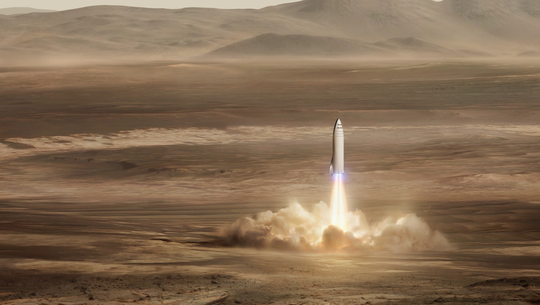Musk says project codenamed BFR would also allow commercial travel to anywhere on Earth in under an hour
Elon Musk has unveiled plans for a new spacecraft that he says would allow his company SpaceX to colonise Mars, build a base on the moon, and allow commercial travel to anywhere on Earth in under an hour.
The spacecraft is currently still codenamed the BFR (Big Fucking Rocket). Musk says the company hopes to have the first launch by 2022, and then have four flying to Mars by 2024.
Last year Musk proposed an earlier plan for the spacecraft, but at the time had not developed a way of funding the project.
Speaking at the International Astronautical Congress in Adelaide Australia on Friday, Musk said the company had figured out a way to pay for the project.
The key, he said, was to “cannibalise” all of SpaceX’s other products.
Instead of operating a number of smaller spacecrafts to deliver satellites into orbit and supply the International Space Station, Musk said the BFR would eventually be used to complete all of its missions.
“If we can do that then all the resources that are used for Falcon9, Dragon and Heavy can by applied to this system,” he said.
SpaceX has been working feverishly on reusable spacecraft designs, now completing 16 successful landings in a row of its Falcon9 rocket. That was the key to allowing the ambitious design to be economic, he said.
“It’s really crazy that we build these sophisticated rockets and then crash them every time we fly,” he said. “This is mad.”
Musk said the cost of fuel is low, and so if the crafts were fully reusable, the costs of flights drop dramatically. He said the company had already started building the system, with construction of the first ship to begin next year.
“I feel fairly confident that we can complete the ship and be ready for a launch in five years,” he said.
By 2024, Musk said he wanted to fly four ships to Mars, two of which would have crew in them. By that stage, they planned to be able to build a plant on the surface of Mars that would be able to synthesise fuel for return journeys back from Mars.
For a trip to Mars, he said the craft would be able to hold about 100 people in 40 cabins. But he said once the ship is built, it could be used to travel on Earth too.
Musk did not estimate the cost of such flights, but said that most long-distance flights could be completed in 30 minutes, and you could get anywhere on Earth in under an hour.
“If we’re building this thing to go to the Moon and Mars then why not go to other places on earth as well,” he said.
He said the size of the payload – which would allow items with a diameter of just under 9m – means larger satellites could be delivered to orbit in a single mission.
At a presentation at last year’s International Astronautical Congress in Guadalajara, Mexico, Musk described the earlier iteration of the system with more details about the costs.
For that earlier version, he said the cost of sending a person on the SpaceX Interplanetary Transport System would be around $200,000. Musk suggested that multiple space rockets could take 100 people each over 40 to 100 years until a million people lived there.
“It was much too big and fantastical,” said Robert Zubrin, president and founder of Mars Society, a non-profit that promotes human settlement of Mars.
Musk’s proposal for getting a million people to Mars as quickly as possible was, Zubrin said, “like a D-Day landing”. Instead, Musk should be thinking of sending just ten people to set up an agricultural base, Zubrin said.
“Then send 20 more people and so forth to develop capabilities to make steel and eventually create institutions like schools.”
“He typically goes into something with over-reach,” Zubrin added, referring to Musk’s tendency to over-promise with many of his projects, including delivery dates of Teslas and the progress of The Boring Company, drilling a subterranean Los Angeles commuter tunnel.
“But he’s able to take criticism and adjust things to become achievable,” said Zubrin.
“If he reduces his launch system from 500 tons to 150 tons or less, that would show he’s serious and would move him from the realm of vision to the realm of engineering.”
Lockheed Martin also presented an idea for a manned Mars mission at the Adelaide event. The aerospace company outlined a six-person space station called Mars Base Camp that it thinks could be orbiting the red planet by 2028 along with a lander that could descend to the surface.
Astronauts on the space station could carry out scientific research and exploration work, including operating rovers and identifying landing spots on the surface of the planet for larger vehicles.
Source: The Guardian

































Leave a Comment
You must be logged in to post a comment.